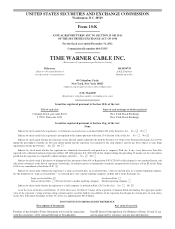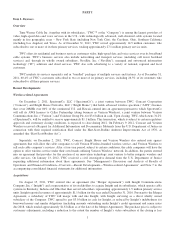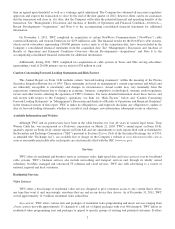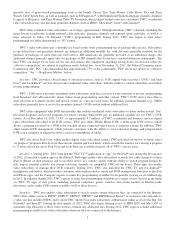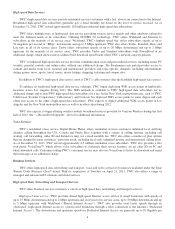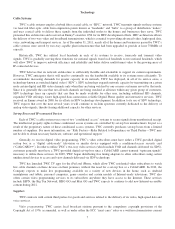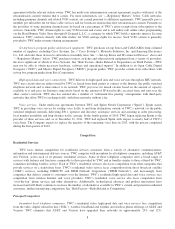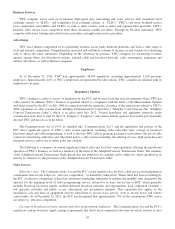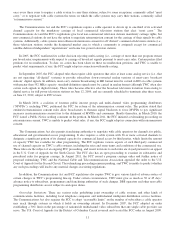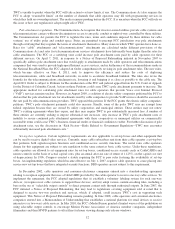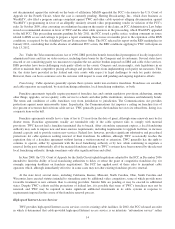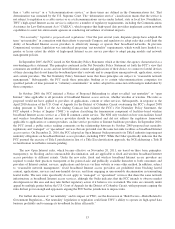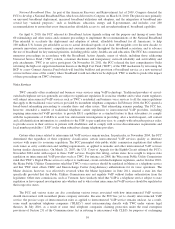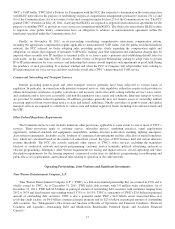Time Warner Cable 2011 Annual Report Download - page 17
Download and view the complete annual report
Please find page 17 of the 2011 Time Warner Cable annual report below. You can navigate through the pages in the report by either clicking on the pages listed below, or by using the keyword search tool below to find specific information within the annual report.respectively, of TWC’s operating areas to carry two-way video, high-speed data and IP-based telephony services, each of
which is similar to the corresponding residential service offered by TWC. Moreover, AT&T and Verizon aggressively
market and sell bundles of video, high-speed data and voice services plus, in some cases, wireless services, and they market
cross-platform features with their wireless services. In addition, both AT&T and Verizon have begun offering services that
allow subscribers to view television programming and rent movies on mobile devices. TWC also faces competition in some
areas from the DSL, wireless broadband and phone offerings of smaller incumbent local telephone companies, such as
Frontier Communications Corporation, Cincinnati Bell, Inc. and CenturyLink, Inc.
Direct broadcast satellite. TWC’s residential video service faces competition from DBS services, such as DISH
Network and DIRECTV. DISH Network and DIRECTV offer satellite-delivered pre-packaged programming services that
can be received by relatively small and inexpensive receiving dishes. These providers offer aggressive promotional pricing,
exclusive programming (e.g., NFL Sunday Ticket) and video services that are comparable in many respects to TWC’s
residential digital video service, including its DVR service and some of its interactive programming features.
In some areas, incumbent local telephone companies and DBS operators have entered into co-marketing arrangements
that allow the telephone companies to offer synthetic bundles (i.e., video service provided principally by the DBS operator,
and DSL, wireline phone service and, in some cases, wireless service provided by the telephone company). From a consumer
standpoint, the synthetic bundles appear similar to TWC’s bundles.
Cable overbuilders. TWC operates its cable systems under non-exclusive franchises granted by state or local
authorities. The existence of more than one cable system, including municipality-owned systems, operating in the same
territory is referred to as an “overbuild.” In some of TWC’s operating areas, other operators have overbuilt TWC’s systems
and offer video, high-speed data and voice services in competition with TWC.
Other Competition and Competitive Factors
Aside from competing with the video, high-speed data and voice services offered by incumbent local telephone
companies, DBS providers and cable overbuilders, each of TWC’s residential services also faces competition from other
companies that provide services on a stand-alone basis.
Video competition. TWC’s residential video service faces competition from a number of different sources, including
companies that deliver movies, television shows and other video programming over broadband Internet connections, such as
Hulu.com, Apple Inc.’s iTunes, Netflix Inc.’s “Watch Instantly” and YouTube. Increasingly, content owners are utilizing
Internet-based delivery of content directly to consumers, some without charging a fee for access to the content. Furthermore,
due to consumer electronics innovations, consumers are able to watch such Internet-delivered content on television sets and
mobile devices. TWC also competes with online order services with mail delivery and video stores.
“Online” competition. TWC’s residential high-speed data service faces competition from a variety of companies that
offer other forms of online services, including low cost dial-up services over telephone lines and wireless broadband services
over a variety of types of networks.
Digital Phone competition. TWC’s residential voice service competes with wireline, wireless and “over-the-top” phone
providers. An increasing number of homes in the U.S. are replacing their traditional wireline telephone service with wireless
phone service, a trend commonly referred to as “wireless substitution.” Wireless phone providers are encouraging this trend
with aggressive marketing and the launch of wireless products targeted for home use. TWC also competes with
“over-the-top” providers, such as Vonage, Skype, magicJack and Google Voice, and companies that sell phone cards at a cost
per minute for both national and international service. In addition, TWC’s residential voice service competes with other
forms of communication, such as text messaging on cellular phones, instant messaging, social networking services and email.
The increase in wireless substitution, the number of different technologies capable of carrying voice services and the number
of alternative communication options available to customers has intensified the competitive environment in which TWC
operates its residential voice service.
Additional competition. In addition to multi-channel video providers, cable systems compete with all other sources of
news, information and entertainment, including over-the-air television broadcast reception, live events, movie theaters and
the Internet. To the extent that TWC’s services converge with theirs, TWC competes with the manufacturers of consumer
electronics products. For instance, TWC’s DVR service competes with similar devices manufactured by consumer
electronics companies.
9


